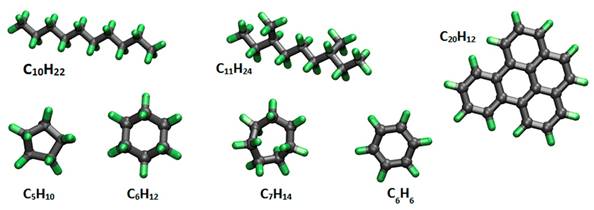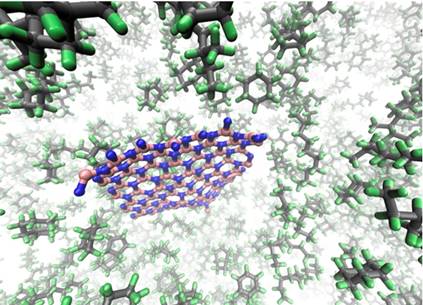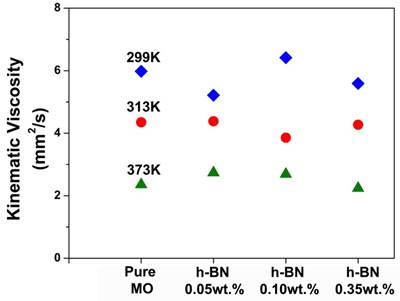Introduction
Materials performance has become more relevant in today’s industrial applications. A prime aspect that has been critical through years is the importance on reducing the inherently losses from friction and wear, which reduce the performance of metal-mechanic processes (Tzanakis et al., 2012). Friction plays an important role in diverse processes such as drilling, cutting, working pair components and mechanisms, among others; causing wear and energy dissipation, which subsequently impact on economic aspect (Jost, 1990). Wear is the major cause of energy and material loss in mechanical processes, as components are in constant friction. However, with utilization of lubricants, components friction and wear could be minimized, resulting into considerable energy and tooling savings (Hernández et al., 2008). Nevertheless, while two or more moving components are in contact, friction generates heat, which could degrade these lubricants; hence, this heat should be dissipated rapidly.
With aid of nanotechnology, recent advances in tribology and heat transport have been observed. For instance, diverse studies have demonstrated that addition of nanoparticles to conventional lubricants can improve their tribological properties (Hernández et al., 2008; Lin, 2007; Taha, 2013; Chang et al., 2010; Hernández et al., 2010; Lee et al., 2012). The addition of nanoparticles to lubricants and heat-transfer fluids (HTFs) has shown superb results in tribological tests, as these could be deposited on the contact surfaces and contribute to friction and wear reduction, also improving load carrying capacity (Peña et al., 2015, 2014; Eswaraiah et al., 2011; Yu et al., 2008; Wu et al., 2007; Peña et al., 2016). Similarly, several researchers have also shown significant enhancements of reinforced HTFs with incorporation of nanoparticles in thermo-physical properties, such as thermal conductivity and viscosity changes involving nanoparticle concentration and temperature changes (Taha et al., 2013, 2012, 2014; Sudeep et al., 2014).
Most of these lubricants and HTFs have the disadvantage of having low thermal conductivity. But when reinforced by these suspended ultrafine structures such as ceramics, metals, semiconductors, carbon nanotubes (CNTs), and composite materials with varied shapes and sizes (<100nm) they possess great potential of application to improve energy efficiency and heat transfer, which could be used in diverse areas and applications such as in power generation, biomedical, tribological, cooling, nuclear, defense, microelectronics, among others (Taha et al., 2014; Sudeep et al., 2014; Eastman et al., 2001; Choi et al., 2008; Gao et al., 2009; Xie and Chen, 2011; Baby and Sundara, 2011; Botha et al., 2011; Balandin, 2011, Choi, 2008). Other factors influencing the thermal transport performance of nanofluids are the liquid layering and viscosity. The viscosity of nanofluids is another important transport property for applications of nanofluids as a new class of HTFs in thermal devices or systems such as heat exchangers or cooling systems. The improvement in thermal conductivity cannot be achieved by increasing the solid filler amount beyond a limit, since increase in filler concentration will increase the viscosity which will adversely affect the fluid properties.
Recently, two dimensional (2D) nanomaterials got remarkable scientific attention due to their unique physical properties and high surface area (Coleman et al., 2011). The bulk counter parts of some of these 2D materials such as graphene and hexagonal boron nitride (h-BN) are already known for their lubrication properties for a long time. h-BN is an effective solid lubricant, it is suitable for diverse applications such as metal-working processes where lubrication at high-temperatures is required and is widely used in high-temperature wear sealing materials of aerospace engines as well as anti-corrosive compound (Taha et al., 2013; Kimura et al., 1999; Pakdel et al., 2011; Husain et al., 2013; Yi et al., 2014; Cho et al., 2013; Golberg et al., 2010; Haubner et al., 2002; Lin and Connell, 2012; Eichler and Lesniak, 2008; Mohan et al., 2013).
Diverse investigations on nanofluids have been conducted, for instance, Hernández et al. (2010) studied the friction behavior of NiCrBSi coatings lubricated by CuO nanoparticles suspended in poly-alphaolephin (PAO6). Block-on-ring tests showed a decrease of up to 100% in the friction coefficient with 2.0wt% CuO. Similarly, Yu et al. (2008) reported improved lubricating properties by adding 0.2wt.% Cu nanoparticles to lubricant oil; in their study Cu formed a soft film by friction-shearing and high pressure reducing the coefficient of friction up to 20%. Wu et al. (2007) examined the tribological properties of nanofluids of API-SF oil (SAE30 LB51153) and base oil, with sphere-like CuO, TiO2, and nano-diamond nanoparticles. Their anti-wear behavior is attributed to the sphere-like morphology of the nanoparticles resulting in a rolling effect between the surfaces; and the deposition of the nanoparticles on the worn surface, decreasing the shearing stress and friction coefficient.
Timofeeva et al. (2007, 2009) studied the thermal conductivity and viscosity of Al2O3 nanoparticles (11nm to 40nm in diameter) dispersed within water and ethylene glycol (EG). It is shown that nanoparticles are highly agglomerated; agglomeration state varies in time, as the sample ages as well. The authors stated that the main parameters for controlling nanofluids’ thermal conductivity enhancement are the geometry, agglomeration state, and surface resistance of nanoparticles. On the other hand, Wang et al. (1999) investigated diverse fluids (water, pump fluid, engine oil and EG) with the addition of Al2O3 and CuO with 28nm and 23nm in diameter, respectively. Wang et al. measured the viscosity of these systems and found an increment as nanoparticles agglomerate, also thermal conductivity performance is observed to decrease; due to an effect of the agglomeration of the nanoparticles. Moreover, particles agglomeration is exacerbated by the size of the reinforced fillers. Furthermore, Nguyen et al. (2007) investigated the particle size effect for Al2O3 aqueous based nanofluids and observed that the particle size effects on viscosity are more significant for high particles concentration.
On thermal transport, Taha et al. (2012) investigated MO reinforced with 2D-nanostructures of h-BN and graphene at low filler fraction (<0.10wt.%), it is observed that the viscosity of the nanofluids decreases significantly with temperature, while the enhancement in viscosity with the addition of 2D-nanofillers is very small (< 2% at 313K). This is an additional advantage of the low filler fractions since the increase in viscosity will decrease the effective thermal conductivity values as well as flow characteristics of the fluid. Moreover, the relatively small increase in viscosity (<30%) at 0.35wt.% of h-BN is evidence that the solution is not flocculating (Taha et al., 2012; Larson, 1998).
In addition to the nanoparticle size, geometry and other liquid layering and Brownian motion aspects of the reinforcements for HTFs, there is an important phenomenon: the thermophoresis effect, which is important in heat transport. This effect includes the increase in effective viscosity of nanofluids due to the presence of nanoparticles and fluid density variation due to variable volume fraction. Kandasamy et al. (2013) observed that the combined effect of thermophoresis and Brownian motion play a very dominant role on heat transfer in the presence of thermal stratification, mainly due to the size of the nanoparticles.
Lubricants can be used to minimize contact friction between components, resulting into considerable energy and tooling savings (Stachowiak and Batchelor, 2005). However, frictional heat generated, when two or more moving surfaces are in contact, could reach high temperatures and needs to be drawn out from the system in an efficient manner, since it can also degrade lubricants or oxidize them; thus, good lubricants must possess adequate thermal conductivity as well. Lubricants thermo-oxidative stability is essential to minimize its degradation during service or storing. Also, changes in fluids viscosity and auto-oxidation are promoted due to the high temperatures reached. These issues have negative effect in lubricant properties; hence, the thermo-stability of lubricants is an important property.
Improvement in thermal transport of nanofluids cannot be achieved by just increasing the solid filler amounts beyond a limit, since increase in filler concentration will increase the viscosity which will adversely affect the fluid properties. With the advancement of computational power, simulation tools are increasingly used for prediction of material (mechanical (Sakhavand et al., 2013; Sakhavand and Shahsavari, 2014), thermal (Raji et al., 2012), electrical (Yuge et al., 2005), etc.) properties. The atoms are modeled individually in this method. The dynamic evolution of the system is governed by the interaction of atoms and calculation of the total potential energy of the system from bonded and non-bonded interactions.
Molecular dynamic (MD) simulations yield information at the atomic or molecular level behaviors, which contribute to the averaged transport properties of the entire fluid-nanoparticle system. The computational domain consists of h-BN nanosheets homogeneously dispersed within mineral oil (MO), which consists of paraffinic, isoparaffinic, naphthenic, aromatic and poly-aromatic compounds such as cyclo-hydrocarbons, benzene and pyrenes (Table 1, Figure 1). The MO is a standard electrical transformer oil, Nytro 10XN, from Nynas (2016). The present study aims at the prediction of the viscosity performance of h-BN/MO nanofluid using MD simulations (Sakhavand and Shahsavari, 2014) and comparison with experimental work.
Table 1 Composition of the MO used in the MD simulation
| Molecule | Wt. % | # Of molecules | # Of atoms |
| C10H22 | 22 | 773 | 24,736 |
| C11H24 | 22 | 708 | 24,780 |
| C5H10 | 17 | 1,212 | 18,180 |
| C6H12 | 17 | 1,010 | 18,180 |
| C7H14 | 18 | 917 | 19,257 |
| C6H6 | 2 | 128 | 1,536 |
| C20H12 | 2 | 40 | 1,280 |
| Total | 100 | 4,788 | 107,949 |
Materials and methods
In our work we performed a liquid exfoliation of micrometer-sized layered h-BN crystals (Sigma Aldrich), where we obtained 2D h-BN nanosheets (ranging from 100 to 500 nm). This process allows us to obtain thin layer nanostructures containing a few atomic layers (~5 layers) that can be stabilized within MO via molecular interactions as well as Brownian motion mechanism (Taha et al., 2012). MD simulations are used to calculate the temperature dependency of viscosity and tribological performance of MO at various filler fraction of 2D hexagonal boron nitride (h-BN) nanosheets. Experimental part of the investigation was previously performed by Taha et al. (2012).
Molecular compositions
MO composition includes paraffinic, isoparaffinic, naphthenic, and aromatic molecules (Table 1). Schematic of the molecules used to simulate the MO are shown in Figure 1. Four different systems are used in this study with 0%, 0.05%, 0.10%, and 0.35% by weight of 2D h-BN suspensions within MO as the base fluid.
Force fields
The consistent valance force field (CVFF) (Rafiee et al., 2013; Albe and Möller, 1998) is used for the interaction of the MO molecules. CVFF has been successfully used to simulate hydrocarbon molecules of crude oil (Sekkal et al., 1998). The in-plane interactions of B and N atoms in h-BN are determined via a bond-order Tersoff-like potential parameterized for BN (Moon and Hwang, 2004), previously used to simulate BN sheets (Vaccarini et al., 2000; Verma et al., 2007; Hansen and McDonald, 1990; Kang and Hwang, 2004). Lennard-Jones (LJ) potential accounts for the cross interactions between h-BN atoms, and MO atoms. The necessary LJ parameters are calculated using standard Lorentz-Berthelot combination rules (Plimpton, 1995) from LJ parameters of MO determined by CVFF and LJ parameters of B and N (Taha et al., 2012). This combination has been used in h-BN and crude oil simulations (Sekkal et al., 1998). A scalable parallel molecular dynamics code, LAMMPS (Plimpton, 1995) was used for the molecular dynamics simulations.
Simulation set-up
A Python computer code was written to randomly place MO molecules and the h-BN flake in a simulation box, while preventing any overlap of the atoms. Temperature dependent studies were performed. For three different temperatures, 299K, 313K, and 373K, each of the four systems (Table 2) was subjected to the following steps to achieve the relaxed structure. First, the system was pressurized for 1.5nano-second (ns) under an isothermal-isobaric ensemble with the corresponding temperature and with 40,000 atmosphere pressure. Next, the system was allowed to relax under the same ensemble and temperature but zero pressure for another 1.5ns. Finally, the system underwent a Canonical ensemble for another 1.5ns. In this way, the system achieves its equilibrium density which varies between 0.65-0.75g/cm3 according to temperature and h-BN concentration (Table 3). Green-Kubo correlation function is used to calculate viscosity at various filler fractions and temperatures (12 systems). The simulations run for 1ns using a correlation length of 500 steps, sample interval of 50 and dump interval of 25,000 steps. Figure 2 illustrates schematic of the simulation set up.
Table 2 Filler fraction (by weight) of h-BN nanosheets within MO
| System | h-BN wt.% | # of BN atoms | # of total atoms |
| 1 | 0.35 | 140 | 108,089 |
| 2 | 0.10 | 40 | 107,989 |
| 3 | 0.05 | 24 | 107,973 |
| 4 | 0 | 0 | 107,949 |
Table 3 Structural properties and viscosity of 12 simulations
| System | h-BN wt.% | Temp. (K) | Vol. (Å 3 ) | Mass (atomic) | Density (g/cm 3 ) | Dynamic Viscosity (Pa-s) | Kinematic Viscosity (mm 2 /s) |
|---|---|---|---|---|---|---|---|
| 1 | 0 | 299 | 1,108,323 | 500,084 | 0.749 | 4.48E-03 | 5.980 |
| 2 | 0 | 313 | 1,132,714 | 500,084 | 0.733 | 3.19E-03 | 4.349 |
| 3 | 0 | 373 | 1,249,002 | 500,084 | 0.665 | 1.57E-03 | 2.357 |
| 4 | 0.05 | 299 | 1,104,987 | 500,382 | 0.752 | 3.92E-03 | 5.215 |
| 5 | 0.05 | 313 | 1,130,496 | 500,382 | 0.735 | 3.22E-03 | 4.383 |
| 6 | 0.05 | 373 | 1,252,162 | 500,382 | 0.664 | 1.82E-03 | 2.736 |
| 7 | 0.10 | 299 | 1,105,696 | 500,580 | 0.752 | 4.82E-03 | 6.417 |
| 8 | 0.10 | 313 | 1,127,608 | 500,580 | 0.737 | 2.84E-03 | 3.854 |
| 9 | 0.10 | 373 | 1,251,500 | 500,580 | 0.664 | 1.79E-03 | 2.687 |
| 10 | 0.35 | 299 | 1,113,598 | 501,821 | 0.748 | 4.18E-03 | 5.592 |
| 11 | 0.35 | 313 | 1,138,643 | 501,821 | 0.732 | 3.12E-03 | 4.270 |
| 12 | 0.35 | 373 | 1,267,188 | 501,821 | 0.658 | 1.47E-03 | 2.240 |
Experimental details
In order to understand the effects of incorporation of nanoparticles within conventional fluids on their physical (viscosity) performance, experimental measurements were performed at various filler fractions over a range of temperature (Taha et al., 2012). The results from these experiments were used to verify the simulation results. Shear viscosity studies were conducted with a TA Instruments ARES rheometer (Couette holder). Temperature-dependent shear viscosity measurements were performed, using room temperature (~299K), 313K and 373K, for various filler fraction of nanofluids. Table 3 illustrates the kinematic viscosity of the 12 simulations. As expected, for all the concentrations, the viscosity decreases as temperature is increased. For the same temperature, the value of viscosity varies for different concentrations. This variation increases as the temperature drops. An overall increase in viscosity is observed by increasing h-BN concentration, especially for temperatures higher than 299K.
Results
In general, the viscosity plays an important role in these nanofluids. It is observed that viscosity decreases significantly with increase in temperature (Figure 3), as expected, while the enhancement in viscosity with the addition of the nanofillers is very small (in low concentrations), which is an advantage of using low filler fractions since the increase in viscosity can decrease the effective thermal conductivity of NFs, as well as flow characteristics of the fluids. Small deviations from the theoretical values of viscosity at higher concentrations of h-BN may be a result of a transition from a dilute to a semi-dilute phase or due to the onset of some small aggregation between the h-BN nanosheets. It has been also observed that lubricants and metal-cutting fluids enhancement in viscosity with the addition of the nanofillers at diverse temperatures is very small (in low filler fractions), which is an advantage of using low filler fractions since the increase in viscosity can decrease the effective thermal conductivity of nanofluids, as well as flow characteristics of the fluids. Countless investigations have focused on improving the thermal dissipation of conventional fluids. Nevertheless, there are certain applications where other important properties and characteristics, besides thermal conductivity, must be taken into account, such as electrical insulation, toxic-less materials and environmentally friendly, to mention a few.
Conclusion
In summary, the viscosity of MO and h-BN complex was calculated for varying temperature and nano-material concentration. Similar to experimental results, the molecular dynamics simulations report temperature-dependent viscosity. The variation of viscosity with the h-BN concentration is not as pronounced in the molecular dynamics simulations as is in the experimental results. This is perhaps due to, first, very small variation of viscosity in the experiment in accordance with the h-BN concentration, and second, due to the inhomogeneity of the force field types used for the hydrocarbons and h-BN atoms. Development of a more accurate force field for the overall MO/h-BN system, along with larger number of atoms in the simulation will result in more exact outcomes.











 nueva página del texto (beta)
nueva página del texto (beta)





